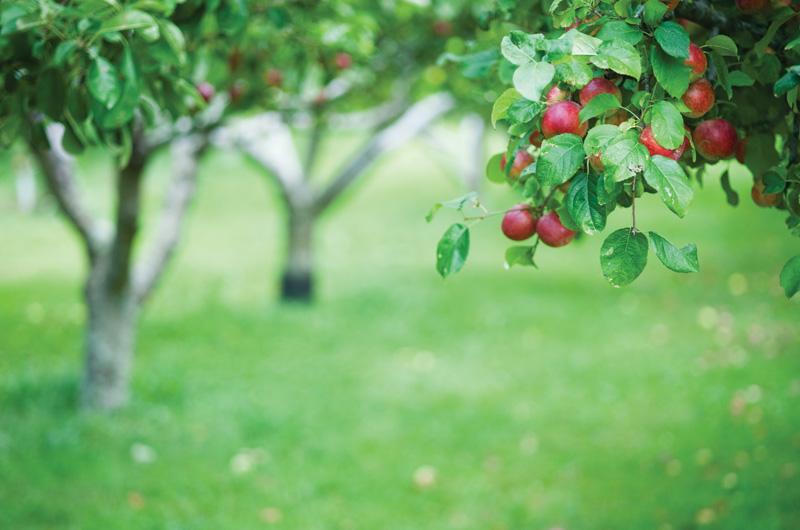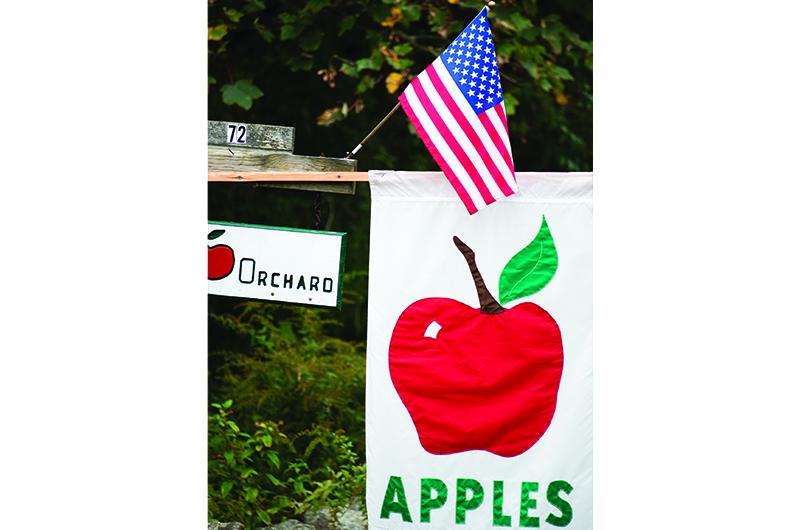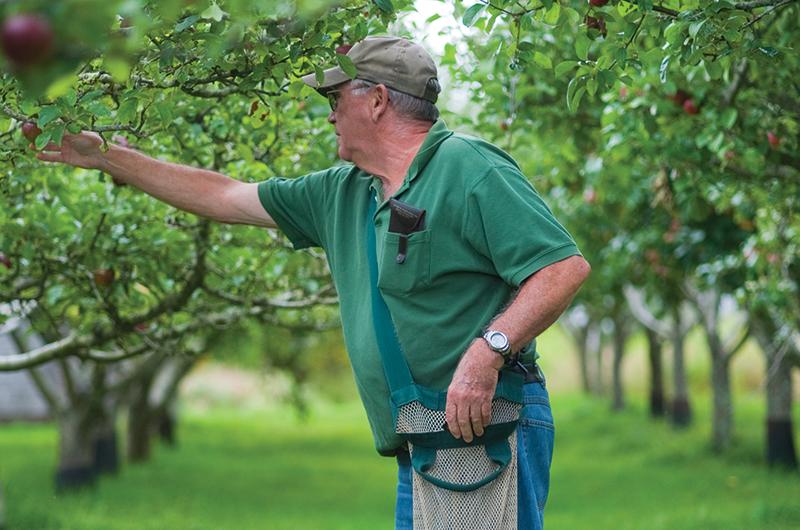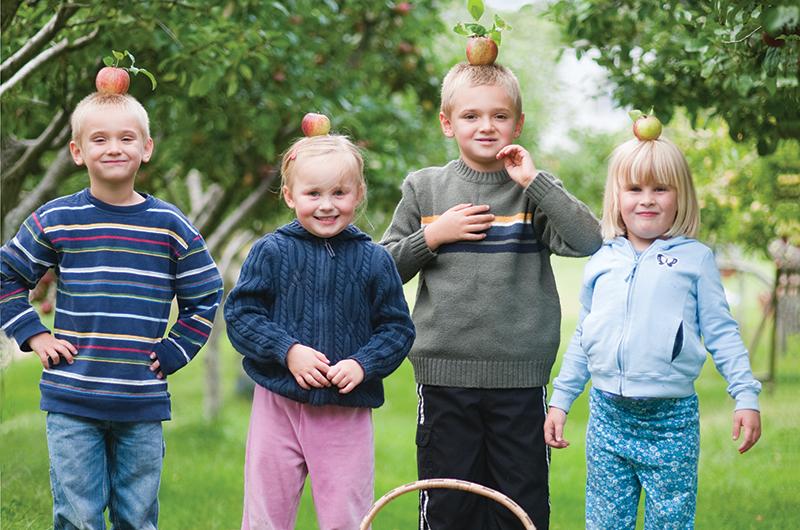
“It was just a hobby” is how C. Eric Magnuson (who goes by Eric) described his foray into growing apples. But his hobby grew into an orchard of more than a hundred trees, becoming the largest apple orchard on Martha’s Vineyard.
The fresh, crisp apples are picked and bagged daily and sold at a self-serve stand outside the Magnusons’ home off State Road in West Tisbury. Tiasquin’s apples are also sold at Alley’s General Store just down the road from the orchard, Morning Glory Farm in Edgartown, Cronig’s Market in Vineyard Haven and West Tisbury, and Fiddlehead Farm in West Tisbury.
Though this season is well under way with an average number of apples on the trees, the family is still talking about last year’s bonanza apple crop – a harvest of a hundred bushels, up from the typical ten to twenty bushels they normally pick. (Each bushel equals about forty-two pounds.) There were so many apples on each tree, the ruby-laden branches nearly touched the ground in places, and Eric used wooden saw horses to prop them up to keep them from breaking. “In bad years, it’s good to have a lot of trees,” he says, but last year, “we were overwhelmed.”

Debbie Magnuson, Eric’s wife of forty-two years, used to operate a beauty salon at the same location and now runs a home day-care business. She baked and cooked her way through last fall: The scents of apple pie, applesauce, a favorite apple cake (recipe follows), and many other creations were a daily benefit born of the excess. Debbie was even putting apples in her pumpkin bread.
Three years ago, they had another great year – not quite as abundant, but equally unpredicted. “I do the same thing every year,” Eric says. “It must be Mother Nature.” Eric, a carpenter by trade, muses about his apple business, saying, “Some years it pays for itself, and some years it doesn’t.”
Apple tree consultant John Bunker of Fedco Trees in Waterville, Maine, agrees that it’s often a mystery why there are really great years and really bad years, but says there can be several reasons. “The easiest explanation is that during bloom, if you get really nice clear weather with relatively mild temperatures, and then you get all the pollinators – honey bees and certain flies are all out there being very active – that may be the best reason why you’ll get a good year.” In central Maine, he explains, this year when apple trees were in full bloom, there were three nights with temperatures in the mid-twenties, which killed the flowers and wiped out many orchards.
What’s in a fruit grower’s control, Bunker emphasizes, is pruning. “If you don’t prune, they stop growing. By pruning, you are stimulating new growth, and that new growth in two to four years will produce fruit buds that will be the fruit of the future.” Some apple varieties, he adds, like to produce fruit every other year.
The Magnusons planted their first five apple trees by the side of their house in 1973, five years after they married. And as their children, Sara and Eric, grew, so did the size of the orchard. Every year, the senior Eric would plant an additional five or six trees, first taking over the vegetable garden, then heading farther and farther back into the field directly behind the house with neat rows spaced about fifteen feet apart. They started selling apples about five or six years after they planted the first trees, and chose the name Tiasquin Orchard, after the Tiasquam Brook, which flows nearby and not far from Eric’s childhood home down the road. (Debbie also grew up in West Tisbury and met Eric when he returned home from the service.) The couple believes Tiasquin is the original spelling of the word, as noted on a stone monument located across the street from their house and in Charles Banks’s History of Martha’s Vineyard, and that either through handwriting or pronunciation, the name evolved into Tiasquam, the more common spelling used today.

Over the years, some new trees replaced those that did not produce, were destroyed by deer, or damaged during Hurricane Bob in 1991. For a few years, because of some health issues Eric had, the orchard fell to temporary neglect. The trees kept producing, but Eric felt the apples weren’t good enough to sell.
In the first years, Eric planted his favorite apple variety, the McIntosh, including some early Mac trees that produce apples in August. Debbie, however, favored the super-crisp, sweet-tart Macoun variety, a cross between a Mac and a Jersey Black. She worked to persuade Eric to plant some, and as evidence, points to one tree in particular. “This is my Macoun tree,” she explains. “It’s the first Macoun tree that we ever planted. He still wasn’t really impressed, until people kept asking for them.” Yet Eric remains steadfast about his own preference. “I like the Mac myself,” he says. A third variety, Liberty (with a crisp texture and sweet flavor), completes the trio that make up about 80 percent of the orchard, though he continuously experiments with other varieties. There’s a deep, purplish-red variety called Arkansas Black; another variety called Wealthy that’s juicy with a complex flavor, great for eating and pie-making; and another called Freedom, which has a flavor similar to a McIntosh. “They’re supposed to be disease-free, but they don’t live up to their name,” Eric says.
He prefers to plant semi-dwarf apple trees because they are easier to maintain. They stand about ten to fifteen feet high and are maintained each year by careful pruning from the end of November when the trees go dormant “until I’m done” in early spring. Eric purchased most of the trees from Miller Nurseries, a family-run fruit-tree business in upstate New York.
During pruning season, Eric uses extended pruners and fashions the trees into a shape resembling an umbrella, taking out many middle branches to allow sun and air to get in – thereby cutting down on some of the many diseases apple trees can get. “It’s quite a science,” says Eric, who learned a lot about apple growing by reading books on the subject.
Debbie says, “When he’s finished in March – it looks like a helicopter upside down, even, all the same height – I don’t know how he does it.”
In spring, before the orchard blossoms and turns the yard into a serenely beautiful landscape, Eric sprays the trees with dormant oil spray, which coats and suffocates problem insects and their eggs. He uses another combination fungicide and insecticide spray occasionally until July, stopping weeks before harvest time. Each year, he depends on bees in the area to pollinate the trees, so fruit can form. The Magnusons also have four crab apple trees known to attract bees (as well as two peach trees, one cherry, and one plum.)

Come harvest, the apples are picked daily as they ripen. It takes a couple of hours a day, sometime more, and Eric’s grandson Michael may help him move the apples. Eric cuts into test apples, and when the seeds have turned brown, the apples are ready. “Each branch ripens at different times, thank God,” he says, referring to last year’s over-abundant harvest.
Tasting is also important when determining ripeness. In an unfortunate twist of fate, a pruning accident around 2000 altered Eric’s ability to fully taste the apples he grows. While pruning, a branch lodged directly into his ear, breaking his eardrum and severing a nerve that affects a person’s sense of smell and taste.
“Now I’m the taster,” says Debbie. She’s also the baker, and as long as they have been growing apple trees, she’s been collecting apple recipes, which she hopes to compile into a book some day. The couple, now with four grandchildren (two who live on-Island), gives to the community by hosting school classes for tours and offering apple cider pressing demonstrations at the Living Local Harvest Fest each fall.
“I want [students] to learn the science of growing apples; they think they’re just from the store,” says Debbie. And who knows, maybe one of those kids might think of starting their own apple orchard, just as a hobby, some day.
The following recipes with apples were originally published along with this article:
The three main types of apples grown at Tiasquin Orchard – McIntosh, Macoun, and Liberty – would all work well in the recipes below for apple cake, crostata, and soup. When making the crostata (a rustic, single-crust pie), it would be nice to combine all three for a subtle depth of apple flavor. Many pie bakers believe using a mix of different apples creates the most complex, flavorful apple pie or crostata. The apple cake and soup will benefit from the addition of any type of apple.
Apple and Celery Root Soup with Cider Swirl






